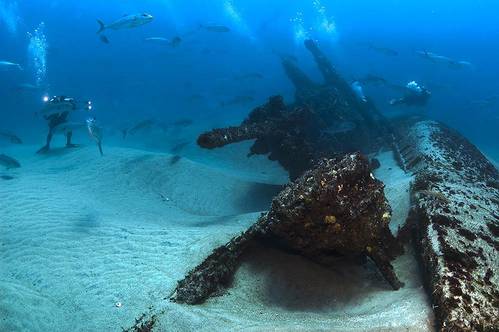NOAA releases expansion proposal for Monitor National Marine Sanctuary; agency asks for public comments through March 18
Following several years of scientific and archaeological assessment and public input, the National Oceanic and Atmospheric Administration (NOAA) has announced plans to consider possible expansion of Monitor National Marine Sanctuary, off the North Carolina coast. The proposed expansion would protect a collection of historically significant shipwrecks including vessels sunk during World War II’s Battle of the Atlantic.
The water’s off North Carolina’s Outer Banks contain the single greatest concentration of World War I and World War II shipwrecks in American waters and includes sunken vessels from U.S. and British naval fleets, merchant ships and German U-boats. Many of the wrecks lie in waters as shallow as 130 feet and serve as popular recreational dive sites.
“For more than 40 years, Monitor National Marine Sanctuary has honored the USS Monitor and the memory and service of her officers and crew,” said David Alberg, Monitor sanctuary superintendent. “The proposed expansion is the result of a collaborative public process and provides an opportunity for us to honor another generation of mariners who rose to the country’s defense when war erupted off America’s shores. Our goal is to protect these ships, these hallowed grave sites, and preserve the special stories they can tell about our maritime and cultural heritage.”
Designated in 1975 as the nation’s first national marine sanctuary, Monitor National Marine Sanctuary protects the wreck site of the Civil War Union ironclad, USS Monitor, which revolutionized naval warfare with its experimental design and rotating turret. The Monitor is best known for its battle with the Confederate armored ship Virginia in Hampton Roads, Va., on March 9, 1862. The engagement ended in a draw, but marked the first time ironclad ships clashed in naval warfare and signaled the end of the era of wooden war ships. The famed Civil War ironclad sank during a storm 16 miles off Cape Hatteras, North Carolina in 1862.
During a review of the sanctuary’s management plan in 2008, NOAA received comments from the public raising the issue of possible expansion. In 2009, the sanctuary’s citizen advisory council voted unanimously to establish a working group to examine the implications of possible expansion.
In June 2014, the working group presented four possible expansion options for public consideration. The models represent several approaches to expansion but are not confined to specific boundaries. A description of each option, including boundaries and the resources the area contains, can be found at http://monitor.noaa.gov/management/expansion.html.
The public is invited to submit comments to the agency on the proposed expansion through March 18. Following the comment period, NOAA may develop a draft environmental impact statement, draft management plan and potential regulations, which will then be available for public review. After reviewing those comments, NOAA would then make a final decision on the proposed expansion. The proposed expansion plans can be found in the Federal Register.
• 

 February 2024
February 2024


